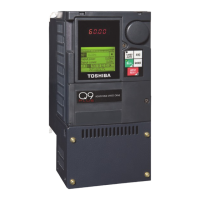14 https://www.toshiba.com/tic/
Installation and Connections
Q9 Plus ASD Install/Op Manual
I/O and Control
The ASD can be controlled by several input types
and combinations thereof, as well as operate within
a wide range of output frequency and voltage
levels. This section discusses the ASD control
methods and supported I/O functions.
The Terminal Board supports discrete and analog
I/O functions and is shown in Figure 9. on pg. 17.
Table 2 lists the names, descriptions, and default
settings (of programmable terminals) of the input
and output terminals of the Terminal Board.
Note: To use the input lines of the Terminal
Board to provide Run commands, the
Command Mode setting must be set to
Terminal Block.
Figure 20. on pg. 19 shows the typical connection
diagram for the Q9 Plus ASD system.
Table 2. Terminal Board Names and Functions.
Terminal
Name
Input/Output
Function (Default Setting If Programmable)
(see Terminal Descriptions on pg. 15)
Circuit Config.
ST
Discrete
Input
Connect to
CC to
activate (Sink
mode).
Standby — Multifunctional programmable discrete input.
Activation required for normal ASD operation.
Figure 10. on pg. 18.
RES
Reset — Multifunctional programmable discrete input.
Activation resets ASD when Faulted — ignored when not
Faulted.
F Forward — Multifunctional programmable discrete input.
R Reverse — Multifunctional programmable discrete input.
S1 Fire Speed — Multifunctional programmable discrete input.
S2
Preset Speed Bit 2 — Multifunctional programmable
discrete input.
S3
Damper Feedback — Multifunctional programmable
discrete input.
S4
Emergency Off — Multifunctional programmable discrete
input.
O1A/B (OUT1)
Switched
Output
Contacts
Damper Command — Multifunctional programmable
discrete form A output contacts.
Figure 16. on pg. 18.
O2A/B (OUT2)
Reach Frequency — Multifunctional programmable discrete
form A output contacts.
FLA Fault relay (N.O.).
Figure 19. on pg. 18.FLB Fault relay (N.C.).
FLC Fault relay (Common).
RR
Analog
Input
Frequency Mode 1 — Multifunctional programmable analog
input. (0.0 to 10 volt input — 0 Hz to Maximum Frequency).
Figure 11. on pg. 18.
RX
Unassigned — Multifunctional programmable analog input
(-10 to +10 VDC input).
Figure 12. on pg. 18.
V/I
(Select V or I
via SW301)
Unassigned — V — Multifunctional programmable isolated
analog voltage input (0 to 10 VDC input).
Figure 13. on pg. 18.Frequency Mode 2 — I (Default setting) — Multifunctional
programmable isolated analog current input (4 [0] to 20
mADC input — 0 Hz to Maximum Frequency).
AM
Analog
Output
Output Current — Current
or Voltage output that is
proportional to the output frequency of the ASD or to the
magnitude of the function assigned to this terminal (see
Table 10 on page 255).
Figure 18. on pg. 18
FM
Output Frequency — Current
or Voltage output that is
proportional to the output frequency of the ASD or to the
magnitude of the function assigned to this terminal (see
Table 10 on page 255). Select Current or Voltage at F681.

